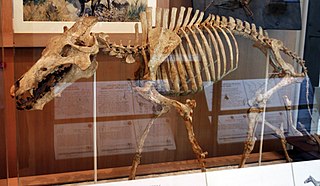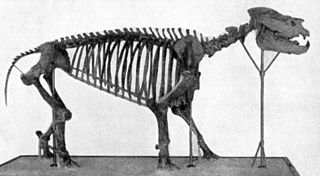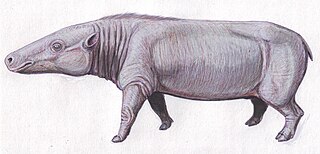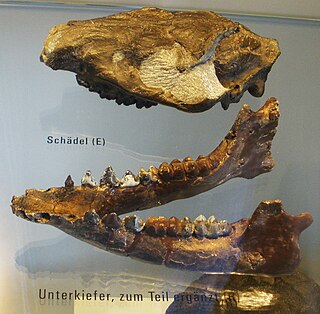
Ungulates are members of the diverse clade Euungulata which primarily consists of large mammals with hooves. Once part of the clade "Ungulata" along with the clade Paenungulata, "Ungulata" has since been determined to be a polyphyletic and thereby invalid clade based on molecular data. As a result, true ungulates had since been reclassified to the newer clade Euungulata in 2001 within the clade Laurasiatheria while Paenungulata has been reclassified to a distant clade Afrotheria. Living ungulates are divided into two orders: Perissodactyla including equines, rhinoceroses, and tapirs; and Artiodactyla including cattle, antelope, pigs, giraffes, camels, sheep, deer, and hippopotamuses, among others. Cetaceans such as whales, dolphins, and porpoises are also classified as artiodactyls, although they do not have hooves. Most terrestrial ungulates use the hoofed tips of their toes to support their body weight while standing or moving. Two other orders of ungulates, Notoungulata and Litopterna, both native to South America, became extinct at the end of the Pleistocene, around 12,000 years ago.

Artiodactyls are mammals belonging to the order Artiodactyla. Typically, they are ungulates which bear weight equally on two of their five toes: the third and fourth, often in the form of a hoof. The other three toes are either present, absent, vestigial, or pointing posteriorly. By contrast, most perissodactyls bear weight on an odd number of the five toes. Another difference between the two is that many artiodactyls digest plant cellulose in one or more stomach chambers rather than in their intestine as perissodactyls do. The advent of molecular biology, along with new fossil discoveries, found that cetaceans fall within this taxonomic branch, being most closely related to hippopotamuses. Some modern taxonomists thus apply the name Cetartiodactyla to this group, while others opt to include cetaceans within the existing name of Artiodactyla. Some researchers use "even-toed ungulates" to exclude cetaceans and only include terrestrial artiodactyls, making the term paraphyletic in nature.

Entelodontidae is an extinct family of pig-like artiodactyls which inhabited the Northern Hemisphere from the late Eocene to the Middle Miocene epochs, about 38-19 million years ago. Their large heads, low snouts, narrow gait, and proposed omnivorous diet inspires comparisons to suids and tayassuids (peccaries), and historically they have been considered closely related to these families purely on a morphological basis. However, studies which combine morphological and molecular (genetic) data on artiodactyls instead suggest that entelodonts are cetancodontamorphs, more closely related to hippos and cetaceans through their resemblance to Pakicetus, than to basal pigs like Kubanochoerus and other ungulates.

Paraceratherium is an extinct genus of hornless rhinocerotoids belonging to the family Paraceratheriidae. It is one of the largest terrestrial mammals that has ever existed and lived from the early to late Oligocene epoch. The first fossils were discovered in what is now Pakistan, and remains have been found across Eurasia between China and the Balkans. Paraceratherium means "near the hornless beast", in reference to Aceratherium, the genus in which the type species P. bugtiense was originally placed.

Megistotherium is an extinct genus of hyaenodont belonging to the family Hyainailouridae that lived in Africa.

Archaeotherium is an extinct genus of entelodont artiodactyl endemic to North America during the Eocene and Oligocene epochs (35—28 mya), existing for approximately 9.1 million years. Archaeotherium fossils are most common in the White River Formation of the Great Plains, but it has also been found in the John Day Basin of Oregon and the Trans-Pecos area of Texas.

Metamynodon is an extinct genus of amynodont that lived in North America and Asia from the late Eocene until early Oligocene, although the questionable inclusion of M. mckinneyi could extend their range to the Middle Eocene. The various species were large, displaying a suit of semiaquatic adaptations more similar to those of the modern hippopotamus, despite their closer affinities with rhinoceroses.

Daeodon is an extinct genus of entelodont even-toed ungulates that inhabited North America about 23 to 20 million years ago during the latest Oligocene and earliest Miocene. The type species is Daeodon shoshonensis, described by a very questionable holotype by Cope. Some authors synonymize it with Dinohyus hollandi and several other species, but due to the lack of diagnostic material, this is questionable at best.

Anthracotheriidae is a paraphyletic family of extinct, hippopotamus-like artiodactyl ungulates related to hippopotamuses and whales. The oldest genus, Elomeryx, first appeared during the middle Eocene in Asia. They thrived in Africa and Eurasia, with a few species ultimately entering North America during the Oligocene. They died out in Europe and Africa during the Miocene, possibly due to a combination of climatic changes and competition with other artiodactyls, including pigs and true hippopotamuses. The youngest genus, Merycopotamus, died out in Asia during the late Pliocene, possibly for the same reasons. The family is named after the first genus discovered, Anthracotherium, which means "coal beast", as the first fossils of it were found in Paleogene-aged coal beds in France. Fossil remains of the anthracothere genus were discovered by the Harvard University and Geological Survey of Pakistan joint research project (Y-GSP) in the well-dated middle and late Miocene deposits of the Pothohar Plateau in northern Pakistan.
The Early Miocene is a sub-epoch of the Miocene Epoch made up of two stages: the Aquitanian and Burdigalian stages.
Brachyhyops is an extinct genus of entelodont artiodactyl mammal that lived during the Eocene Epoch of western North America and southeastern Asia. The first fossil remains of Brachyhyops are recorded from the late Eocene deposits of Beaver Divide in central Wyoming and discovered by paleontology crews from the Carnegie Museum of Natural History during the early 20th century. The type species, Brachyhyops wyomingensis, is based on a single skull and was named by E.H. Colbert in 1937, but was not officially described until 1938. During the latter half of the 20th century, additional specimens from North America have been recorded from Saskatchewan and as far south as Texas, indicating that Brachyhyops had a broad distribution and was well-dispersed throughout western North America.
Duerotherium is an extinct genus of Paleogene artiodactyls known only from the Iberian Peninsula during the Middle Eocene, which contains one species D. sudrei. It, like other members of the Anoplotheriidae, was endemic to western Europe. The anoplotheriine was described from a left fragment of a maxilla from the Mazaterón Formation of the Duero Basin in 2009. Its dentition is mostly typical of the Anoplotheriinae but differs by an elongated plus triangular 3rd upper premolar and very specific traits of the molars. It is thought to have been part of an endemic faunal assemblage that evolved within the Iberian Peninsula by the Middle Eocene, where climates were subtropical.

Agriochoerus is an extinct genus of scansorial herbivore of the tylopod family Agriochoeridae, endemic to North America. Agriochoerus and other agriochoerids possessed claws, which is rare within Artiodactyla, as well as likely being scansorial. Agriochoerus was first described in 1869.
Dermotherium is a genus of fossil mammals closely related to the living colugos, a small group of gliding mammals from Southeast Asia. Two species are recognized: D. major from the Late Eocene of Thailand, based on a single fragment of the lower jaw, and D. chimaera from the Late Oligocene of Thailand, known from three fragments of the lower jaw and two isolated upper molars. In addition, a single isolated upper molar from the Early Oligocene of Pakistan has been tentatively assigned to D. chimaera. All sites where fossils of Dermotherium have been found were probably forested environments and the fossil species were probably forest dwellers like living colugos, but whether they had the gliding adaptations of the living species is unknown.

Cainotheriidae is an extinct family of artiodactyls known from the Late Eocene to Middle Miocene of Europe. They are mostly found preserved in karstic deposits.

Microbunodon was a genus of extinct artiodactyl mammals in the family Anthracotheriidae. It lived between the upper Eocene and the lower Pliocene. Its fossil remains have been found in Europe and Asia.

Helohyidae were a group of artiodactyl mammals. They were most prominent in the mid-to-upper Eocene.

Bachitherium is an extinct genus of Paleogene ruminants that lived in Europe from the late Eocene to the late Oligocene. The genus was erected in 1882 by Henri Filhol for Bachitherium curtum, the type species, and B. insigne; five more species have since been named although one, B. sardus, is currently pending reassessment. The genus name derives from "Bach", the French locality where its first fossils were found, and the Greek θήρ/therium meaning "beast". Bachitherium has historically been assigned to various families within the ruminant infrorder Tragulina, but was reclassified to its own monotypic family Bachitheriidae by Christine Janis in 1987.

Palaeohypsodontus is an extinct genus of small size Bovidae from Oligocene with unclear systematic position. It was originally described from a jaw fragment for P. asiaticus, from Mongolia, Middle Oligocene. The second species, P. zinensis was found in the Upper Oligocene of Pakistan and China.
Robiatherium is an extinct genus of Paleogene artiodactyls containing one species R. cournovense. The genus name derives from the locality of Robiac in France where some of its fossil were described plus the Greek θήρ/therium meaning "beast" or "wild animal." It was known only from the middle Eocene and, like other anoplotheriids, was endemic to western Europe. The genus was erected by Jean Sudre in 1988 for a species originally attributed to the xiphodont genus Paraxiphodon in 1978. Robiatherium had dentitions typical of the subfamily Anoplotheriinae, differing from other genera by specific differences in the molars. It is one of the earliest-appearing anoplotheriine species in the fossil record as well as the earliest to have appeared in central Europe.
















